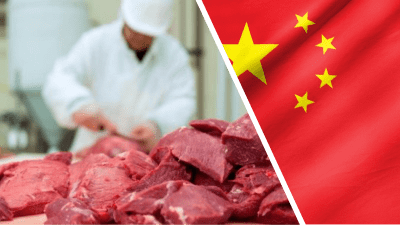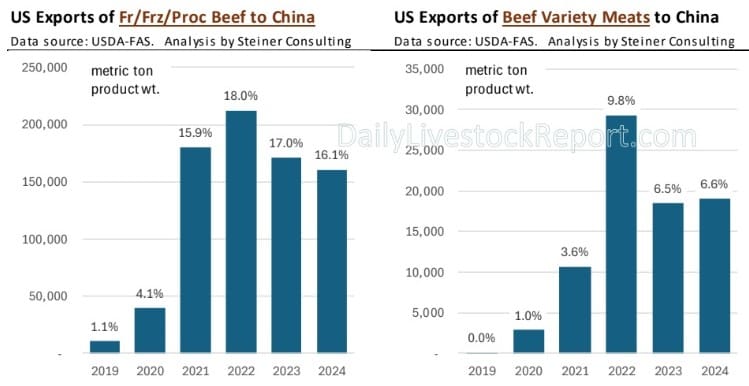GLOBAL stock market and currency pendulums swung wildly again overnight, as US President Donald Trump again took the world by complete surprise, announcing 90-day pauses on the implementation of higher tariffs on a raft of countries selling goods into the US.
The immediate impact overnight has been dramatic rises in listed stocks on exchanges in both the United States and Australia, and a spectacular recovery (this morning, at least) in the value of the Aussie dollar.
 The Aussie lost US3.6c or 5.7pc over three days after last week’s tariff announcement, falling to 59.5c yesterday, before mounting a mini-recovery this morning to US61.7c, following overnight Trump news.
The Aussie lost US3.6c or 5.7pc over three days after last week’s tariff announcement, falling to 59.5c yesterday, before mounting a mini-recovery this morning to US61.7c, following overnight Trump news.
All of this is highly damaging for confidence among consumers, and the global beef trade.
Overnight, Trump has delayed for three months the implementation of higher tariffs (those countries beyond the blanket 10pc rate), affecting nations like Japan, Korea, the EU and Vietnam. The exception to that was China, where Trump has doubled-down on earlier tariff moves.
Here’s what’s unfolded in US/China tariff developments over the past week.
In response to the original US announcement on reciprocal tariffs last Thursday (34pc on China, 10pc minimum on a bunch of other countries, including Australia and Brazil), the China Tariff Commission announced additional 34pc tariffs on all goods imported from the US, effective April 10. The White House subsequently announced an additional 50pc tariff on Chinese goods, raising the total tariff rate to 104pc.
China responded yesterday with an additional 50pc retaliatory duty on US goods. The additional 50pc tariff push China’s effective duty rate on US beef and beef variety meat to 106pc. These rates represented the sum total of China’s 12pc most-favoured-nation tariff, plus retaliatory duties previously imposed by China, plus the new 34pc duty that was already set to take effect April 10, plus the additional 50pc duty.
Since then, the ‘tit-for-tat’ exchange has continued, with Trump overnight pushing the US tariff level on China to 125pc. It remains to be seen whether China responds.
All out trade war
If a trade war with China was a risk last week, today it is a full-blown conflict, with no resolution in sight, Steiner Consulting’s Daily Livestock Report suggested this morning.
“Current Chinese tariffs on US beef, pork and other agricultural products are at levels that will likely shut off the market for US livestock producers,” DLR wrote overnight.
As of this morning, Chinese tariffs on US beef and beef variety meats are 106pc.The effective tariff on US pork and pork variety meat exports to China now stands at 131pc, Steiner wrote.
“US beef was already among the most expensive in the world, which had impacted export volumes to China in recent years,” Steiner said. “At this point, we do not expect to see much US beef going into that market.”
Also worth noting, China has yet to renew a long list (more than 100) of US beef plant certifications for China access that expired in March. Current trade tensions might make that unlikely, trade sources suggest.
What does it mean for Australia?
So how significant are US beef exports to China, and will it impact trade out of Australia?
The bar graphs published below plot US beef and beef offal trade volume into China over the past six years. The percentage labels above the annual values indicate China’s share of total US exports.

Source: Daily Livestock Report
Beginning in 2021, China opened its market to more US beef following commitments made under the Phase One bilateral trade agreement. Almost overnight, China became the third-largest market for US beef, by volume. China’s purchases of beef offals have remained relatively small. Last year, total US exports of beef and beef offals to China reached US$1.58 billion, with beef cuts making up the vast majority (US$1.52b). This accounted for 16pc of all US beef exports last year.
“With 25.2 million head of fed cattle slaughtered in the US in 2024, this implies that beef exports to China were worth about US$63 per head (fed),” Steiner calculated.
“As US beef currently going to China shifts to other markets or domestic US channels, higher tariffs on US beef imports may help offset some of this displacement,” it said.
“Still, it’s important to remember that the US typically imports less expensive beef (used for grinding – ie Australian trimmings for hamburgers) and exports higher-value cuts. If those exported cuts remain in the domestic market and replace imported grinding beef, there will be a value loss.”
Beyond beef, more than half of the volume of US pork variety meat exports was shipped to China in 2024, and it will be difficult to find alternative markets that can absorb that volume or contribute comparable value to US exports, Steiner said. The value of pork exports to China (cuts plus offal) was US$994 million in 2024, or US$7.70 per hog slaughtered, with variety meats accounting for $5/head of that.
